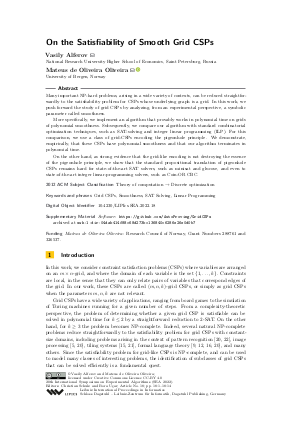On the Satisfiability of Smooth Grid CSPs
Authors
Vasily Alferov,
Mateus de Oliveira Oliveira 
-
Part of:
Volume:
20th International Symposium on Experimental Algorithms (SEA 2022)
Part of: Series: Leibniz International Proceedings in Informatics (LIPIcs)
Part of: Conference: International Symposium on Experimental Algorithms (SEA) - License:
 Creative Commons Attribution 4.0 International license
Creative Commons Attribution 4.0 International license
- Publication Date: 2022-07-11
File

PDF
LIPIcs.SEA.2022.18.pdf
- Filesize: 0.79 MB
- 14 pages
Document Identifiers
Subject Classification
ACM Subject Classification
- Theory of computation → Discrete optimization
Keywords
- Grid CSPs
- Smoothness
- SAT Solving
- Linear Programming
Metrics
- Access Statistics
-
Total Accesses (updated on a weekly basis)
0Document
0Metadata
Abstract
Many important NP-hard problems, arising in a wide variety of contexts, can be reduced straightforwardly to the satisfiability problem for CSPs whose underlying graph is a grid. In this work, we push forward the study of grid CSPs by analyzing, from an experimental perspective, a symbolic parameter called smoothness. More specifically, we implement an algorithm that provably works in polynomial time on grids of polynomial smoothness. Subsequently, we compare our algorithm with standard combinatorial optimization techniques, such as SAT-solving and integer linear programming (ILP). For this comparison, we use a class of grid-CSPs encoding the pigeonhole principle. We demonstrate, empirically, that these CSPs have polynomial smoothness and that our algorithm terminates in polynomial time. On the other hand, as strong evidence that the grid-like encoding is not destroying the essence of the pigeonhole principle, we show that the standard propositional translation of pigeonhole CSPs remains hard for state-of-the-art SAT solvers, such as minisat and glucose, and even to state-of-the-art integer linear-programming solvers, such as Coin-OR CBC.
Cite As Get BibTex
Vasily Alferov and Mateus de Oliveira Oliveira. On the Satisfiability of Smooth Grid CSPs. In 20th International Symposium on Experimental Algorithms (SEA 2022). Leibniz International Proceedings in Informatics (LIPIcs), Volume 233, pp. 18:1-18:14, Schloss Dagstuhl – Leibniz-Zentrum für Informatik (2022)
https://doi.org/10.4230/LIPIcs.SEA.2022.18
BibTex
@InProceedings{alferov_et_al:LIPIcs.SEA.2022.18,
author = {Alferov, Vasily and de Oliveira Oliveira, Mateus},
title = {{On the Satisfiability of Smooth Grid CSPs}},
booktitle = {20th International Symposium on Experimental Algorithms (SEA 2022)},
pages = {18:1--18:14},
series = {Leibniz International Proceedings in Informatics (LIPIcs)},
ISBN = {978-3-95977-251-8},
ISSN = {1868-8969},
year = {2022},
volume = {233},
editor = {Schulz, Christian and U\c{c}ar, Bora},
publisher = {Schloss Dagstuhl -- Leibniz-Zentrum f{\"u}r Informatik},
address = {Dagstuhl, Germany},
URL = {https://drops.dagstuhl.de/entities/document/10.4230/LIPIcs.SEA.2022.18},
URN = {urn:nbn:de:0030-drops-165526},
doi = {10.4230/LIPIcs.SEA.2022.18},
annote = {Keywords: Grid CSPs, Smoothness, SAT Solving, Linear Programming}
}
Author Details
Funding
- de Oliveira Oliveira, Mateus: Research Council of Norway, Grant Numbers 288761 and 326537.
Supplementary Materials
-
Software
https://github.com/AutoProving/GridCSPs
browse
 archived version
archived version
References
- Gilles Audemard and Laurent Simon. On the glucose SAT solver. Int. J. Artif. Intell. Tools, 27(1):1840001:1-1840001:25, 2018. URL: https://doi.org/10.1142/S0218213018400018.
-
Paul Beame, Henry Kautz, and Ashish Sabharwal. Towards understanding and harnessing the potential of clause learning. Journal of Artificial Intelligence Research, pages 319-351, 2004.

-
Paul Beame and Toniann Pitassi. Simplified and improved resolution lower bounds. In Foundations of Computer Science, 1996. Proceedings., 37th Annual Symposium on, pages 274-282. IEEE, 1996.

-
Samuel R Buss, Jan Hoffmann, and Jan Johannsen. Resolution trees with lemmas: Resolution refinements that characterize DLL algorithms with clause learning. Logical Methods in Computer Science, 4, 2008.

-
Alessandra Cherubini, Stefano Crespi Reghizzi, Matteo Pradella, and Pierluigi San Pietro. Picture languages: Tiling systems versus tile rewriting grammars. Theoretical Computer Science, 356(1):90-103, 2006.

-
Mateus de Oliveira Oliveira. Satisfiability via smooth pictures. In International Conference on Theory and Applications of Satisfiability Testing, pages 13-28. Springer, 2016.

-
Niklas Eén and Niklas Sörensson. An extensible SAT-solver. In Theory and applications of satisfiability testing, pages 502-518. Springer, 2003.

-
John Forrest and Robin Lougee-Heimer. Cbc user guide. In Emerging theory, methods, and applications, pages 257-277. INFORMS, 2005.

-
Dora Giammarresi and Antonio Restivo. Recognizable picture languages. International Journal of Pattern Recognition and Artificial Intelligence, 6(2&3):241-256, 1992.

-
Armin Haken. The intractability of resolution. Theoretical Computer Science, 39:297-308, 1985.

-
Philipp Hertel, Fahiem Bacchus, Toniann Pitassi, and Allen Van Gelder. Clause learning can effectively P-simulate general propositional resolution. In Proc. of the 23rd National Conference on Artificial Intelligence (AAAI 2008), pages 283-290, 2008.

-
Changwook Kim and Ivan Hal Sudborough. The membership and equivalence problems for picture languages. Theoretical Computer Science, 52(3):177-191, 1987.

-
Jan Krajíček. Lower bounds to the size of constant-depth propositional proofs. The Journal of Symbolic Logic, 59(01):73-86, 1994.

-
Jan Krajíček, Pavel Pudlák, and Alan Woods. An exponential lower bound to the size of bounded depth frege proofs of the pigeonhole principle. Random Structures & Algorithms, 7(1):15-39, 1995.

-
Michel Latteux and David Simplot. Recognizable picture languages and domino tiling. Theoretical computer science, 178(1):275-283, 1997.

-
Hermann A Maurer, Grzegorz Rozenberg, and Emo Welzl. Using string languages to describe picture languages. Information and Control, 54(3):155-185, 1982.

-
Matthew W Moskewicz, Conor F Madigan, Ying Zhao, Lintao Zhang, and Sharad Malik. Chaff: Engineering an efficient SAT solver. In Proceedings of the 38th annual Design Automation Conference, pages 530-535. ACM, 2001.

-
Knot Pipatsrisawat and Adnan Darwiche. On the power of clause-learning SAT solvers as resolution engines. Artificial Intelligence, 175(2):512-525, 2011.

-
Toniann Pitassi, Paul Beame, and Russell Impagliazzo. Exponential lower bounds for the pigeonhole principle. Computational complexity, 3(2):97-140, 1993.

-
Azriel Rosenfeld. Picture languages: formal models for picture recognition. Academic Press, 2014.

-
David Simplot. A characterization of recognizable picture languages by tilings by finite sets. Theoretical Computer Science, 218(2):297-323, 1999.

-
Gift Stromoney, Rani Siromoney, and Kamala Krithivasan. Abstract families of matrices and picture languages. Computer Graphics and Image Processing, 1(3):284-307, 1972.

